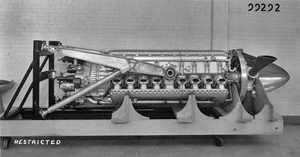Chrysler IV-2220
| IV-2220 | |
|---|---|
 |
|
| IV-2220, perhaps a display model (note the cutaway prop). The length of the engine is evident, made even longer by the large accessories section on the left. | |
| Type | Piston aircraft engine |
| Manufacturer | Chrysler |
| First run | 1945 |
| Major applications | Curtiss XP-60C |
The Chrysler XIV-2220 (XI-2220 from 1944) was an experimental 2,500 hp 2,220 cubic inch/36.4 litre liquid-cooled inverted-V-16 aircraft engine designed by Chrysler starting in 1940. Although several aircraft designs had considered using it, by the time it was ready for use in 1945 the war was already over. Only a few engines were built during the program, and it retained its 'X' designation the entire time as the XIV-2220, later XI-2220. The IV-2220 is historically important as it was Chrysler's first hemi, a design that would re-appear for many years later and is now a Chrysler trademark.
Chrysler had apparently been carrying out paper studies of a very large engine for a brief period starting in May 1940 and decided to present their work to the United States Army Air Corps. They proposed a large engine to provide 2,500 hp initially, with room for growth upwards. Instead of using advanced features such as sleeve valves for improved RPM, they instead decided to use a larger number of "normal sized" cylinders in a V-16 arrangement. The Army was interested, and sent them a development contract tender on June 22, 1940, to which Chrysler responded on July 2.
The extremely long profile of the new design meant that the crankshaft would be highly loaded if power was taken off at the propeller end. Chrysler's solution to this problem was unique; power was instead taken from the middle of the engine, placing the propeller reduction gear in a gap between two V-8 cylinder banks and sending power to the front of the engine via a long extension shaft running below the crankshaft. Additionally many of the accessories were driven off the drive shaft instead of the crank shaft. This solution also raised the weight of the engine by the amount of the shaft, but it was apparently a price worth paying.
A single overhead cam drove the two-per-cylinder poppet valves, arranged at an angle to the piston in a hemi-spherical cylinder head, with the spark plug arranged between the valves. This arrangement allowed for "cross-flow" scavenging of the charge, and had been used on various race and performance car engines for some time. The hemi is actually less efficient than the design being used in most engines of the era, the penta engine, which improved airflow by allowing three or four valves per cylinder.
...
Wikipedia
